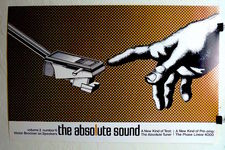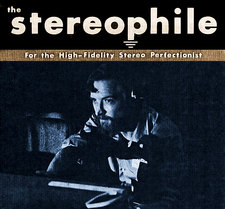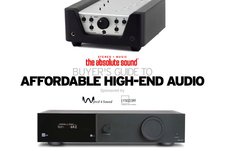It’s the time of year for saving money!
When I was just a kid, and our hobby was nearly as young as I was, about the only sources that I could turn to for information about hi-fi were the public library (Do you remember those? When was the last time you were actually in one?), magazines like Popular Science, Popular Mechanics and Popular Electronics, and High Fidelity Magazine, which if I remember correctly, was, with its first issue published for April of 1951, the first of the actual hi-fi enthusiast publications.
 Frankly, although all of those were chock full of all sorts of stuff that my young mind absorbed like (and certainly with all the discrimination of) a sponge, and I still remember many things from that era, (including the “sweet sixteen” speaker system that I built after reading about it in Popular Electronics sometime in the early 1960s), by modern standards, none of them were really of much use to a newbie trying to pick – whether to be bought new or used, or to be built from kits or schematics – the components for a new system.
Frankly, although all of those were chock full of all sorts of stuff that my young mind absorbed like (and certainly with all the discrimination of) a sponge, and I still remember many things from that era, (including the “sweet sixteen” speaker system that I built after reading about it in Popular Electronics sometime in the early 1960s), by modern standards, none of them were really of much use to a newbie trying to pick – whether to be bought new or used, or to be built from kits or schematics – the components for a new system.
Part of that may have been because our whole industry was still in “discovery” mode, with many of the things that we take for granted today (the Fletcher-Munson “loudness” curves, for example, or the Thiele/Small parameters for speaker design) still, along with transistors, completely unknown, and even “classics” like the Williamson amplifier circuit not “classics” at all, but still new, fresh and exciting, we simply didn’t have a whole lot of knowledge to communicate or all that much choice of equipment to communicate it about.
Another part was that there was a lot of stuff that we were simply wrong about: One of those was the idea of frequency-response “balance”, which more than one “expert” of the time said was more important than frequency-response extension. Although I don’t remember the name of any particular book or its author, I DO remember that [at least] one book on high fidelity sound systems that I got from the library said that, if your system’s bass response was limited to 50Hz (pretty decent bottom-end performance, even for big speakers back then) you should – in the interests of balance – limit its treble response to no more than 15kHz at the top. (Until 1960, instead of “Hertz”, we called it “cycles-per-second” [“CPS”]. Although in modern times we do look for balance in LEVEL at the frequency-response extremes, I doubt that anyone today believes that we should just arbitrarily cut off frequency-response capability at one end of the frequency-response spectrum because of a lack of capability at the other. That would be madness; but no madder than the other idea we all held back then that, because the electronics were of such low distortion (1% or less) as to be inaudible, only its electromechanical elements (the speaker and phono cartridge) had any significant effect on a hi-fi system’s sound quality.
 Mostly, though, the problem was that the books and magazines of the day simply didn’t give any kind of critical reviews of hi-fi gear, so they couldn’t be of much help to us in making a choice. Oh, yes, certainly publications like Consumer Reports did do occasional evaluations of hi-fi products – I bought my Rek-O-Kut L34 turntable specifically because of one such evaluation – but what Consumer Reports and everybody else did was just to test and comment on the mechanical performance (speed accuracy, wow and flutter, and rumble) and build quality of the product under evaluation instead of giving any kind of review of what it actually sounded like.
Mostly, though, the problem was that the books and magazines of the day simply didn’t give any kind of critical reviews of hi-fi gear, so they couldn’t be of much help to us in making a choice. Oh, yes, certainly publications like Consumer Reports did do occasional evaluations of hi-fi products – I bought my Rek-O-Kut L34 turntable specifically because of one such evaluation – but what Consumer Reports and everybody else did was just to test and comment on the mechanical performance (speed accuracy, wow and flutter, and rumble) and build quality of the product under evaluation instead of giving any kind of review of what it actually sounded like.
In fact, it wasn’t until the advent of Stereophile Magazine (1962) , and a decade later (1973), the absolute sound and of people like their founder/editor/publishers, J. Gordon Holt and Harry Pearson, that “subjective” reviewing – actually listening to audio equipment and telling what it sounds like, instead of just measuring it — came along, bringing with it, on the one hand, a vast proliferation of reviewers, good, bad, and indifferent, both professional and amateur; a similar profusion of audio review publications and blogs; and an ongoing war between the “subjectivists” (the “listeners”) and the “objectivists” (the “testers”) that shows no sign of ever going away.
And that’s a great thing! For one reason, because (at least to me) it’s immensely entertaining. Another, probably more important, reason is because in these modern times there are quite literally thousands of products IN TENS OF MILLIONS OF POSSIBLE COMBINATIONS competing for our attention and our purchase dollars, and no matter how hard any of us might try or how much time and effort we might put into it, THERE’S NO WAY THAT ANY ONE OF US COULD EVER AUDITION (or probably even learn of the existence of) EVEN A VERY SMALL PERCENTAGE OF THEM FOR OURSELVES.
 You think I’m kidding? Or exaggerating? Or (remember, I used to be a cable designer, so I might be) crazy or lying in my teeth? Well, consider this: The last time I counted, there were more than four hundred brands (NOT models, just brands of speakers on the market. There were also many, many, brands of source components, electronics, phono gear, cables, accessories, and a near-infinite number of rooms in which to play them, all of which will affect the sound that will be heard.
You think I’m kidding? Or exaggerating? Or (remember, I used to be a cable designer, so I might be) crazy or lying in my teeth? Well, consider this: The last time I counted, there were more than four hundred brands (NOT models, just brands of speakers on the market. There were also many, many, brands of source components, electronics, phono gear, cables, accessories, and a near-infinite number of rooms in which to play them, all of which will affect the sound that will be heard.
Because trying to listen to that many things in all of their possible combinations is impossible, just on the face of it, let’s cut it down to more usable proportions: Let’s assume that we’re talking about a phono-only system, and that for each of the elements of that system, there are only ten models of product available: Ten phono cartridges; ten tonearms; ten turntables; ten phono cables; ten preamps; ten preamp-to-amplifier interconnects; ten amplifiers; ten speaker cables; and ten speakers. Let’s further assume that we’re going to do all of our listening in the same room; that we will listen to each single combination of products for only ten minutes; that there will be no time required for setting-up or changing the systems and components; and that we – with the superhuman powers bestowed upon us by our Golden Ears — require no sleep and can continue our auditioning process 24/7 for as long as it takes. How long do you think that might be?
Well, let’s see: 10 cartridges times 10 tonearms equals 100; times 10 turntables equals 1000; times 10 phono cables equals 10,000; times 10 preamps equals 100,000; times 10 interconnects equals 1,000,000; times 10 amplifiers equals 10,000,000; times 10 speaker cables equals 100,000,000; times 10 speakers equals 1 BILLION; times 10 minutes listening-time per combination equals 10 BILLION MINUTES to accomplish our task.
 Now, just exactly how long do you think that is? To find out, let’s divide 10,000,000,000 minutes by 60 minutes per hour to get 166,666,667 hours (10,000,000,000 ÷ 60 = 166,666,667 hours); and let’s divide that by 24 hours per day (166,666,667 ÷ 24 = 6,944,444 days), and divide the remainder by 365 days per year (6,944,444 ÷ 365 = 19,026 years). Yup, IT WOULD TAKE MORE THAN NINETEEN THOUSAND YEARS OF NON-STOP LISTENING! And before the end of even the very first of all those years, new products would have arisen and old ones would have died or been replaced, and we’d have to start all over again!
Now, just exactly how long do you think that is? To find out, let’s divide 10,000,000,000 minutes by 60 minutes per hour to get 166,666,667 hours (10,000,000,000 ÷ 60 = 166,666,667 hours); and let’s divide that by 24 hours per day (166,666,667 ÷ 24 = 6,944,444 days), and divide the remainder by 365 days per year (6,944,444 ÷ 365 = 19,026 years). Yup, IT WOULD TAKE MORE THAN NINETEEN THOUSAND YEARS OF NON-STOP LISTENING! And before the end of even the very first of all those years, new products would have arisen and old ones would have died or been replaced, and we’d have to start all over again!
THAT’S why we need reviews and the reviewers who write them – it’s in order to spread the work among many of us so that we all can have at least some idea of what’s available; what’s good; and what isn’t. In Part 2 of this new series, I’ll tell you a little more about the reviewing process and about the people we rely on to share the initial listening process with us so that we don’t have to even attempt to do it all for ourselves.
Hopefully I’ll see you then.





